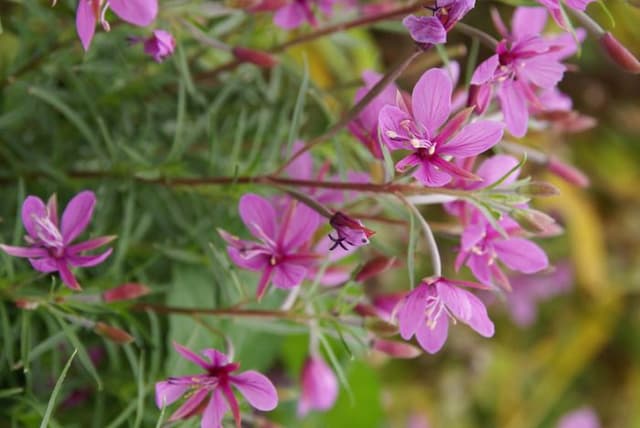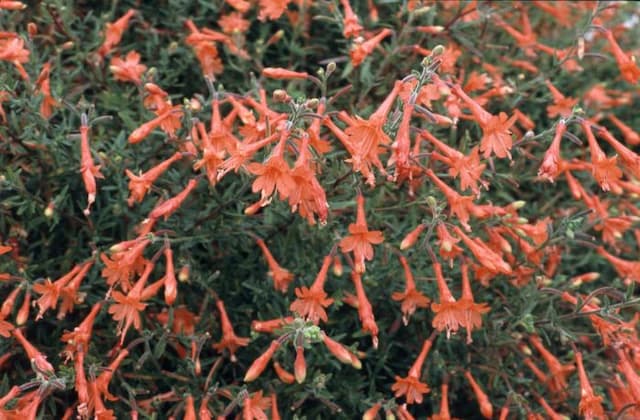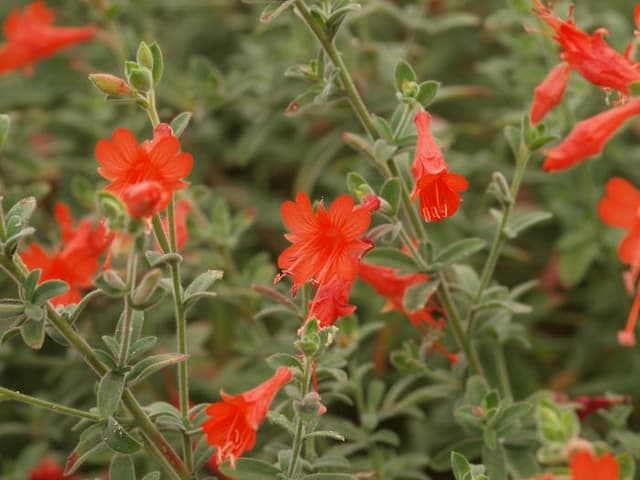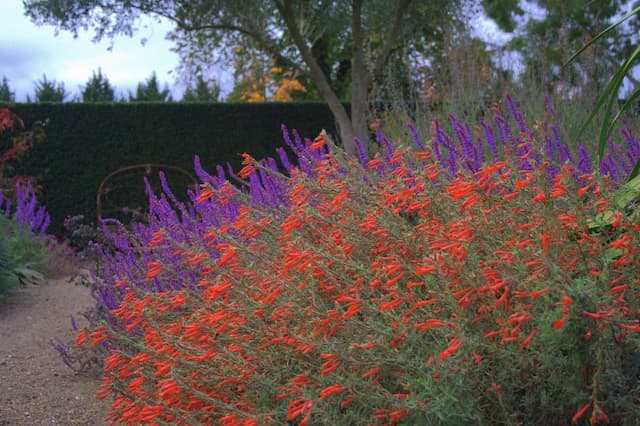Hardy Fuchsia Fuchsia magellanica

ABOUT
The plant known as hardy fuchsia features a graceful, arching growth habit with slender branches. Its leaves are a deep green color, which contrast strikingly with the red and purple hues of the dangling, teardrop-shaped flowers. These flowers are particularly distinctive, characterized by their elongated, tubular shape and the way they seem to dangle off the stems, giving the plant a delicate and somewhat exotic appearance. Each flower is composed of four long, slender sepals that are typically a vivid reddish-purple, surrounding softer purple-pink petals that enclose the flower's stamen and pistil, creating a two-tone effect that is both eye-catching and elegant. The leaves are oval with a slight point at the tip and have a serrated edge, and they grow opposite each other along the stem. The overall impression of the hardy fuchsia is one of a rich tapestry of color and form, with its graceful flowers nodding in the breeze and creating a lively display that can continue throughout the growing season.
About this plant
 Names
NamesSynonyms
Hardy Fuchsia, Hummingbird Fuchsia, Lady's Eardrops
Common names
Fuchsia macrostemma, Fuchsia magellanica var. macrostemma, Fuchsia magellanica var. molinae
 Toxicity
ToxicityTo humans
Hardy fuchsia is not considered toxic to humans. It does not contain significant amounts of compounds known to cause serious poisoning, and accidental ingestion of parts of this plant typically does not result in any severe symptoms. However, like with any plant, individual allergies or sensitivities can occur, so it is generally advisable to avoid eating plants not known to be safe or intended for consumption.
To pets
Hardy fuchsia is generally considered non-toxic to pets including cats and dogs. It does not contain substances known to be significantly poisonous to pets, so it is unlikely that ingestion will cause more than mild stomach upset, if any symptoms at all. However, individual animals may react differently, and it is always best to prevent pets from eating non-food plants as a precaution.
 Characteristics
CharacteristicsLife cycle
Perennials
Foliage type
Deciduous
Color of leaves
Green
Flower color
Mixed
Height
10 feet (3 meters)
Spread
4 feet (1.2 meters)
Plant type
Shrub
Hardiness zones
6
Native area
Southern Chile, Argentina
Benefits
 General Benefits
General Benefits- Ornamental Value: Fuchsia magellanica, commonly known as hardy fuchsia, has striking two-toned flowers that add aesthetic appeal to gardens and landscapes.
- Habitat for Wildlife: The plant provides a food source for pollinators like bees and hummingbirds, supporting biodiversity.
- Shade Tolerant: Hardy fuchsia can thrive in partial shade, making it versatile for planting under trees or in other shaded areas of the garden.
- Long Blooming Period: It has a long flowering season, often from summer into fall, offering prolonged visual interest.
- Low Maintenance: The plant is relatively easy to care for, requiring minimal pruning and being tolerant of a range of soil conditions.
- Cold Hardy: Fuchsia magellanica is more cold-resistant than many other fuchsia species, making it suitable for cooler climates.
 Medical Properties
Medical Properties- Antioxidant: Fuchsia magellanica may have compounds with antioxidant effects.
- Anti-inflammatory: Some studies suggest potential anti-inflammatory properties.
- Antimicrobial: There could be antimicrobial activity in some parts of the plant.
 Air-purifying Qualities
Air-purifying QualitiesThis plant is not specifically known for air purifying qualities.
 Other Uses
Other Uses- Fuchsia magellanica, commonly known as hummingbird fuchsia, can be planted as a hedging shrub in landscaping, especially in cooler climates where it can grow lush and dense.
- The flowers of the hummingbird fuchsia can be used in making natural dyes for fabrics, yielding various shades of purples and pinks depending on the mordant used.
- Its berries are edible and can be made into jams, jellies, or pies, though they are not as commonly used in culinary traditions as some other berries.
- The plant's striking appearance is ideal for adding visual interest to butterfly and hummingbird gardens, as its blooms attract these pollinators.
- In cooler coastal areas, hummingbird fuchsia can be used for erosion control, as its root system helps to stabilize the soil on slopes.
- Florists sometimes use the graceful flowers of the hummingbird fuchsia in creating exotic and vibrant floral arrangements.
- Crafters can incorporate the dried flowers and seed pods into decorative wreaths or potpourri mixtures.
- Photographers and artists often use this plant as a subject for their work due to its intense color and ornamental structure.
- Hummingbird fuchsia can be used in educational settings like botanical gardens to illustrate plant growth habits and flower structure for studies in botany and horticulture.
- Its ability to thrive in the understory makes it a good choice for planting beneath larger trees and shrubs in multi-layered garden designs.
Interesting Facts
 Feng Shui
Feng ShuiThe hardy fuchsia is not used in Feng Shui practice.
 Zodiac Sign Compitability
Zodiac Sign CompitabilityThe hardy fuchsia is not used in astrology practice.
 Plant Symbolism
Plant Symbolism- Confiding Love: Fuchsia magellanica, often referred to as hardy fuchsia, is sometimes associated with confiding love, representing a trusting relationship where feelings are shared openly.
- Elegance and Good Taste: The plant's elegant drooping flowers suggest refinement and the appreciation of aesthetic beauty, symbolizing individuals who have a great sense of style and sophistication.
- Ardent Affection: Its vivid colors and unique shape are often linked to deep and heartfelt affection, symbolizing strong and passionate emotions towards someone.
 Water
WaterHardy fuchsia, or Fuchsia magellanica, should be watered deeply and thoroughly, with the soil being kept consistently moist but not waterlogged. During the active growing season in spring and summer, water approximately once or twice a week, applying about 1 to 2 gallons per plant depending on the size and the weather conditions. Reduce watering in the fall and water sparingly in winter, only when the soil is dry to touch. Ensure proper drainage to prevent root rot.
 Light
LightHardy fuchsia thrives in a location where it receives morning sunlight and afternoon shade or dappled sunlight throughout the day. Avoid exposing it to the harsh afternoon sun, which can cause leaf scorch. The ideal spot is one that mimics its natural understory habitat, offering bright but filtered light.
 Temperature
TemperatureHardy fuchsia performs best in a temperature range of 60 to 75 degrees Fahrenheit. It can survive minimum temperatures of around 30 degrees Fahrenheit, but frost can damage the plant. Ensure protection or move it indoors if temperatures approach the lower limit. The ideal conditions are moderate and avoid extreme heat or cold.
 Pruning
PruningPruning hardy fuchsia encourages new growth and a bushier form. It should be pruned in the spring, after the threat of frost has passed. Remove dead or damaged branches, and trim back about a third of the previous year's growth to promote healthy new shoots. Pruning can be done annually or every few years as needed to maintain shape.
 Cleaning
CleaningAs needed
 Soil
SoilHardy Fuchsia prefers moist, well-draining soil with a pH between 6 to 7. A mixture of loam, peat moss, and perlite or sand works well to maintain the necessary balance of drainage and moisture retention. Amend the soil with organic matter to enhance fertility.
 Repotting
RepottingHardy Fuchsia typically needs repotting every two to three years or when it outgrows its current container. It's best to repot in the spring before the growing season starts.
 Humidity & Misting
Humidity & MistingHardy Fuchsia thrives in moderate to high humidity levels, ideally around 60-70%. Avoid placing it in excessively dry conditions to maintain its health and bloom quality.
 Suitable locations
Suitable locationsIndoor
Use bright indirect light, keep soil moist, protect from drafts.
Outdoor
Plant in dappled shade, shelter from wind, ensure moist soil.
Hardiness zone
6-9 USDA
 Life cycle
Life cycleFuchsia magellanica, commonly known as hardy fuchsia, begins its cycle with seed germination in warm, moist soil conditions. The seedlings emerge and develop into small shrubs with long, arching branches. As the plants mature, they produce distinctive tear-drop shaped buds which blossom into the characteristic pendulous flowers, commonly pink and purple, attracting pollinators throughout the growing season. Following pollination, the plants set fruit in the form of small, dark berries which can either fall to the ground to self-sow or be dispersed by birds and other animals, leading to new plants if conditions are favorable. In colder climates, they die back to the ground after frost but can resprout from the roots in spring; in milder regions, they can remain evergreen and continue growth. The plants can also be propagated vegetatively through cuttings to create clones of the parent plant, ensuring the continuation of its life cycle.
 Propogation
PropogationPropogation time
Spring-Summer
Fuchsia magellanica, commonly known as hardy fuchsia, is often propagated through softwood cuttings. These cuttings are best taken in late spring or early summer when the plant's growth is most vigorous. To propagate using softwood cuttings, one would cut a young growing tip about 4 to 6 inches (10 to 15 centimeters) long, ensuring there are at least two sets of leaves. The lower set of leaves is removed, and the cut end of the stem is dipped into rooting hormone. The cutting is then placed in a soil mixture that is kept moist but not waterlogged. In favorable conditions, the cutting typically roots in a few weeks, after which it can be potted up or eventually transplanted into the garden.









